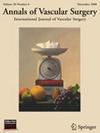气囊可膨胀与自膨胀支架移植用于髂分支装置血管内修复主动脉-髂动脉瘤:系统回顾和荟萃分析。
IF 1.6
4区 医学
Q3 PERIPHERAL VASCULAR DISEASE
引用次数: 0
摘要
背景:比较使用球囊可膨胀支架(BESG)与自膨胀支架(SESG)合并髂内动脉(IIA)的结果,同时使用髂分支装置(IBD)进行主动脉-髂动脉瘤的血管内修复。方法:进行系统综述和荟萃分析。PubMed、Embase和Cochrane数据库检索了截至2024年12月的研究,这些研究比较了主动脉髂动脉瘤血管内修复期间IBD的BESG和SESG。按照PRISMA方案共筛选了1107篇文章。终点包括所有内漏,1b型,1c型和3型内漏,臀部跛行,IIA闭塞,以及随访期间ibd相关的再干预。结果:4项队列研究符合入选标准,684例ibd患者接受了711例ibd治疗。460例(64.7%)采用BESG, 251例(35.3%)采用SESG。两组的人口统计数据和心血管危险因素相似。患者中位年龄为71.1岁,男性占88.7%。与BESG治疗的患者相比,SESG治疗的所有内漏(OR 5.53; 95% CI 1.15至26.63;P= 0.03;I2= 0)的发生率明显低于BESG治疗。1 b型(或4.62;95%可信区间0.18 - 116.16;P = .35点),1型c(或1.52;95%可信区间0.09 - 25.03;P = .77点),3型endoleaks(或5.25;95%可信区间0.58 - 47.47;P = .14点),臀部跛行(或0.38;95%可信区间0.06 - 2.58;P = 32, I2 = 0%),活动花絮闭塞(或0.40;95%可信区间0.06 - 2.57;P =点;I2 = 0%),和IBD-related reinterventions(或1.62;95%可信区间0.84 - 3.11;P =含量;I2 = 0%)组之间没有显著差异。结论:在使用IBD进行主动脉髂动脉瘤血管内修复时,与BESG相比,SESG治疗IIA与所有类型的内漏发生率较低相关。然而,1b型、1c型、3型内漏、臀部跛行、IIA闭塞和ibd相关再干预在SESG和BESG中相似。BESG更通用,以适应具有挑战性的解剖条件。本文章由计算机程序翻译,如有差异,请以英文原文为准。
Balloon-Expandable Versus Self-Expandable Stent Grafts for Endovascular Repair of Aorto-Iliac Aneurysms with Iliac Branch Devices: A Systematic Review and Meta-Analysis
Background
To compare the results of internal iliac artery (IIA) incorporation using balloon-expandable stent grafts (BESGs) versus self-expandable stent grafts (SESGs) while using iliac branch devices (IBDs) for endovascular repair of aorto-iliac artery aneurysms.
Methods
A systematic review and meta-analysis was conducted. PubMed, Embase, and Cochrane databases were searched for studies up to December 2024 that compared BESG and SESG for IBD during endovascular repair of aorto-iliac aneurysms. A total of 1,107 articles were screened following the Preferred Reporting Items for Systematic Reviews and Meta-Analyses protocol. End points included a composite of all endoleaks, types 1b, 1c, and 3 endoleaks, buttock claudication, IIA occlusion, and IBD-related reinterventions during follow-up.
Results
Four cohort studies met the eligibility criteria with 684 patients treated with 711 IBDs. 460 (64.7%) BESGs and 251 (35.3%) SESGs were used in the target IIAs. Both groups had similar demographics and cardiovascular risk factors. The median age of patients was 71.1 years and 88.7% were male. A composite of all endoleaks (odds ratio [OR]: 5.53; 95% confidence interval [CI]: 1.15 to 26.63; P = 0.03; I2 = 0) was significantly less common in patients treated with SESG compared to BESG. Type 1b (OR: 4.62; 95% CI: 0.18–116.16; P = 0.35), type 1c (OR: 1.52; 95% CI: 0.09–25.03; P = 0.77), type 3 endoleaks (OR: 5.25; 95% CI: 0.58–47.47; P = 0.14), buttock claudication (OR: 0.38; 95% CI: 0.06–2.58; P = 0.32; I2 = 0%), IIA occlusion (OR: 0.40; 95% CI: 0.06–2.57; P = 0.34; I2 = 0%), and IBD-related reinterventions (OR: 1.62; 95% CI: 0.84–3.11; P = 0.15; I2 = 0%) were not significantly different between groups.
Conclusion
SESG for IIA was associated with a lower incidence of all types of endoleaks when compared to BESG during endovascular repair of aorto-iliac aneurysms using IBD. However, types 1b, 1c, and 3 endoleaks; buttock claudication; IIA occlusion; and IBD-related reinterventions were similar among SESG and BESG. BESG is more versatile to adjust to challenging anatomical conditions.
求助全文
通过发布文献求助,成功后即可免费获取论文全文。
去求助
来源期刊
CiteScore
3.00
自引率
13.30%
发文量
603
审稿时长
50 days
期刊介绍:
Annals of Vascular Surgery, published eight times a year, invites original manuscripts reporting clinical and experimental work in vascular surgery for peer review. Articles may be submitted for the following sections of the journal:
Clinical Research (reports of clinical series, new drug or medical device trials)
Basic Science Research (new investigations, experimental work)
Case Reports (reports on a limited series of patients)
General Reviews (scholarly review of the existing literature on a relevant topic)
Developments in Endovascular and Endoscopic Surgery
Selected Techniques (technical maneuvers)
Historical Notes (interesting vignettes from the early days of vascular surgery)
Editorials/Correspondence

 求助内容:
求助内容: 应助结果提醒方式:
应助结果提醒方式:


